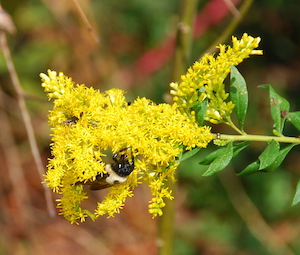
By Terry W. Johnson
This summer, much of Georgia has suffered from a combination of high temperatures and drought conditions. For example, only a 10th of an inch of rain fell at my home in middle Georgia in September. In spite of two recent rains, as I write this column, the rainfall totals in Macon are still some 9 inches below normal. In addition, daily temperatures in late summer often spurred heat indexes topping 100.
While these conditions had a negative impact on all of us, the effect on wild plant and animal communities has been potentially far worse. And those effects could continue well beyond 2019.
With that in mind, let's look at a few of the ways drought can stress the natural world.
When Forbs Fail
When it is extremely dry, plants often bear less fruit and fewer berries and seeds. Studies have found, for example, that drought can affect the size of the acorn crop many native oaks produce. Acorns are a food staple for everything from wood ducks and white-tailed deer to small mammals and songbirds.
The drought has been especially hard on the group of plants that biologists call forbs. Forbs include a wide range of herbaceous, broad-leaved plants, such as wildflowers, legumes and a host of others most folks refer to simply as weeds. Yet it’s safe to say that forbs are probably the most underrated food plants for wildlife. They are critical to the diets of deer, rabbits and even wild pollinators.
When conditions are extremely dry, forbs produce fewer stems, flowers and seeds. Usually, they are a significant source of protein for animals that graze on them. However, during a drought, the stems and leaves are less palatable and nutritious. This can affect grazers in many ways, such as causing females to produce less milk for their young. As a result, during drought years the females often raise fewer young.
This year, countless forbs have withered and even died before they flowered. Others did not produce blossoms. This translates into less pollen and nectar. The low number of butterflies recorded on many butterfly counts this summer could be a reflection of drought's impact on these key sources of nectar.
Fallout for Migrants
Remarkably, 96 percent of terrestrial birds eat insects. Since insect populations typically plummet during a drought, nesting adults struggle to feed their young. This can mean fewer young fledged.
Also, since the vast majority of songbirds migrating through Georgia this fall passed through the state during the drought’s peak, the lack of berries, fruits, seeds and insects undoubtedly affected these creatures, too. Songbirds stop along their migration pathways to feed – or refuel – and then continue on their epic journeys. If birds stopping in Georgia found less food, their ability to complete the southbound flight to their wintering grounds could have been compromised.
I am particularly concerned about monarchs. Even in a normal year, monarchs have a difficult time finding enough food to fuel their southward migration. Studies have shown that the availability of nectar plants on the monarchs' migratory pathway affects the number that reach their winter home in Mexico It will be interesting to see if fewer of the monarchs that passed through the Peach State this autumn ultimately reached Mexico.
Obviously, drought also affects the availability of water. When water is scarce, animals have to travel greater distances to find it. This makes them more vulnerable to predators. In the case of nesting birds, this means they are forced to spend more time away from their young, increasing the odds their nests will be discovered by predators.
As small pools and wetlands dry up, amphibians, fish and other aquatic organisms either disappear or suffer population losses.
Many of the flying insects eaten by swallows, chimney swifts, bats and other aerial predators are raised in these habitats. When these insects are in short supply, the animals that eat them also suffer.
What You Can Do
While there is little that homeowners can do to offset the negative impacts of drought across a broad landscape, we can affect conditions in our own backyards. Here are a few simple ways you can help the wild plants and animals living in your yard survive a drought:
- Provide a source of water. Anything from a shallow pan to a birdbath will suffice, but put at least one water source on the ground for animals that cannot reach a birdbath on a pedestal.
- Incorporate native food plants into your yard. Plants native to your area are often better able to survive drought than ornamentals. Native plants also can produce up to four times more insects.
- Use liberal amounts of mulch around the plants in your gardens. This will help your garden soil retain precious moisture.
- Plant a variety of native plants to produce pollen and nectar, seeds, berries, and fruit over as much of the year as possible. Include native trees, shrubs and other plants that will benefit migratory birds and butterflies passing through our yards in late summer and fall.
- Keep feeders stocked with a variety of foods, such as seeds (white millet and black oil sunflower seeds are the best) and suet.
As wildlife habitat continues to disappear or become degraded, our yards are becoming more important to our wild plant and animal neighbors. This is the case regardless of the weather, but the significance of your yard to wildlife can be even more critical during drought and other weather extremes.
Terry W. Johnson is a former Nongame program manager with the Wildlife Resources Division and executive director of The Environmental Resources Network, or TERN, friends group of the division’s Nongame Conservation Section. (Permission is required to reprint this column.) Learn more about TERN, see previous “Out My Backdoor” columns, read Terry’s Backyard Wildlife Connection blog and check out his latest book, “A Journey of Discovery: Monroe County Outdoors.”